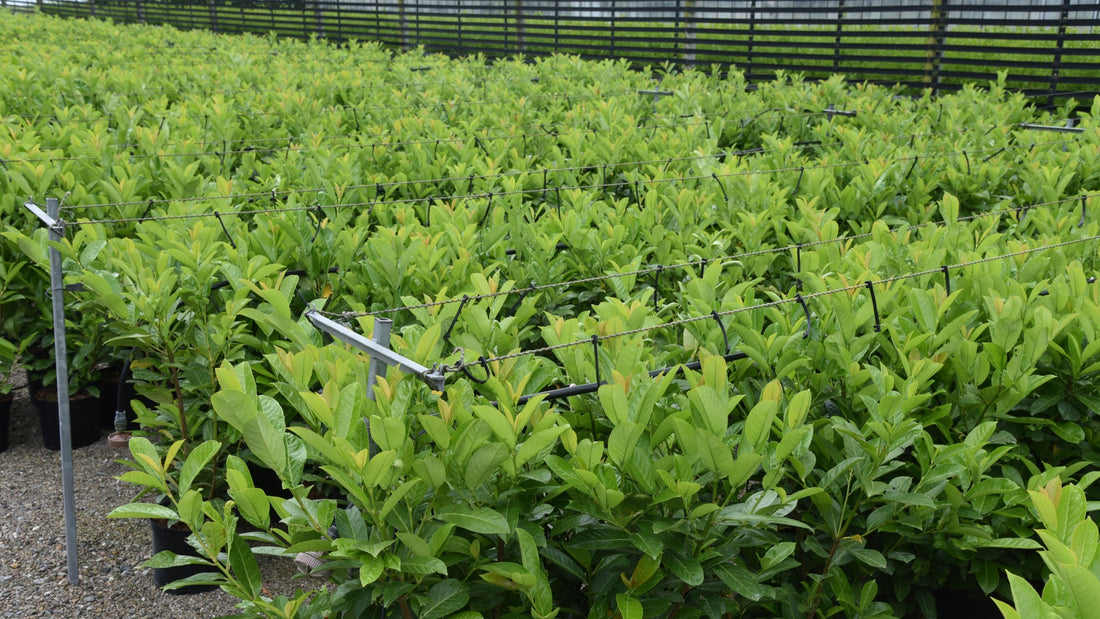
How to care for Cherry Laurel
Share
Cherry Laurel (Prunus laurocerasus) is a versatile, robust, and attractive ornamental hedging plant well-suited for creating privacy screens. Cherry laurel can tolerate a wide range of growing conditions, but proper care is essential to prevent issues such as yellowing leaves and leaf drop. Here’s a comprehensive guide to help you grow and maintain a healthy cherry laurel hedge.
How to Grow Cherry Laurel
Where to grow?
Cherry laurel thrives in well-drained soil and can tolerate various soil types, from clay to sandy loam. It can grow in both full sun and partial shade, although it tends to produce more flowers and fruit in sunnier spots. As a fast-growing shrub, it can reach heights of 5 meters or more, but regular pruning can keep it smaller and more manageable.
What can I plant in front of a cherry laurel hedge?
Plant drought-tolerant perennials and evergreens that contrast with the laurel’s green foliage. Consider the soil and light conditions when selecting companion plants.
Planting Cherry Laurel
- Digging the Hole: Dig a hole slightly larger than the root system. Ensure the base of the stem is level with the surrounding soil, if planting bareroot then fan out the roots.
- Planting: Place the plant in the hole, backfill with soil, and firm it gently around the roots to remove air pockets.
- Watering: Water thoroughly after planting to help the plant establish. Add mulch to retain moisture.
Caring for Cherry Laurel
Watering
- Establishment Phase: Water regularly during dry spells, especially in summer. Avoid overwatering, as cherry laurel does not tolerate waterlogged soil.
- Mature Plants: Once established, cherry laurel is relatively drought-tolerant but still benefits from regular watering during prolonged dry periods.
Mulching
Apply a layer of organic mulch, such as bark chips or leaf mould, around the base of the plant annually. This helps retain moisture, suppress weeds, and provide nutrients.
Pruning
Pruning promotes bushier growth, maintains shape, and prevents the hedge from becoming too large. The best time to prune is late spring or early summer after flowering:
- Tools: Use sharp, clean pruning shears.
- Technique: Remove dead, diseased, or damaged branches first. Then, trim back the tips of branches to the desired height.
- Safety: Wear gloves and protective clothing, as cherry laurel leaves and branches contain toxic compounds that can cause skin irritation.
Pests and Diseases
Known Issues
- Leaf Spot: Brown spots on leaves. Prevent by avoiding overhead watering and ensuring good air circulation.
- Powdery Mildew: White coating on leaves. Prevent by avoiding overcrowding and ensuring good air circulation.
- Laurel Shot Hole: Holes in leaves, often mistaken for insect damage. Caused by a fungus, it’s more common in damp conditions and dense foliage. Treat with an appropriate fungicide.
Brown rot and laurel shot can be treated with fungicides such as pyraclostrobin/boscalid, chlorothalonil, or azoxystrobin
Troubleshooting Yellowing Leaves
Causes and Solutions
- Watering Issues: Both overwatering and underwatering can cause Cherry Laurel's yellow leaves. The key is to ensure the soil is well-draining and the plants are watered from the base when the soil is dry to the touch.
- Nutrient Deficiency: A lack of essential nutrients, especially nitrogen, can lead to yellowing leaves. Apply a balanced fertilizer to correct deficiencies. Iron deficiency can also cause the leaves to turn yellow, this more commonly occurs on chalky soil and can be corrected with a spray.
- Soil Conditions: Poor drainage or compacted soil can stress roots. Improve drainage and aerate the soil if needed. Sitting in waterlogged soil can lead to root rot which causes leaves to turn yellow and drop.
- Pests and Diseases: Regularly inspect for pests and treat infestations promptly. Fungal diseases may require fungicide treatment.
- Improper Fertilization: Avoid over-fertilizing and use the correct type of fertilizer. Slow release fertilizers containing bone meal are ideal.
Environmental Considerations
Root System
Cherry laurel has a large, fibrous root system that can damage nearby structures. Plant at least a couple of meters from buildings and structures, especially in clay soil, to avoid potential damage.
Conclusion
Cherry laurel is a hardy, versatile plant that can enhance your garden with its dense foliage and fast growth. By understanding its needs and addressing potential issues like yellowing leaves, you can enjoy a healthy and attractive hedge. Regular care, proper planting techniques, and timely pruning will ensure your cherry laurel remains a beautiful and functional part of your garden



